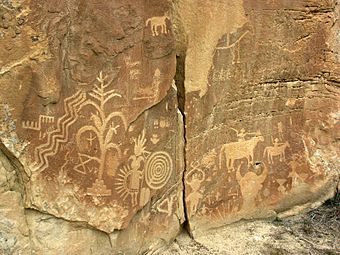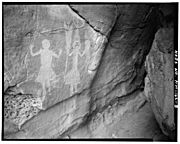Crow Canyon Archaeological District facts for kids
|
Crow Canyon Archeological District
|
|

Rock art at Crow Canyon
|
|
| Nearest city | Farmington, New Mexico |
|---|---|
| Area | 3,200 acres (1,300 ha) |
| Architectural style | Hogans & Pueblitos |
| NRHP reference No. | 74001200 |
Quick facts for kids Significant dates |
|
| Added to NRHP | July 15, 1974 |
The Crow Canyon Archaeological District is a special historical area. It is located in New Mexico, about 30 miles southeast of Farmington. This region is the traditional homeland of the Navajo people. It has the largest collection of Navajo and Ancient Pueblo rock art in the United States.
These amazing rock carvings, called petroglyphs, are found on the canyon walls. They show ceremonial scenes and symbols. These images tell stories about the Navajo people's traditions and beliefs. The petroglyphs were made between the 16th and 18th centuries. They have stayed well-preserved despite weather and visitors. The Crow Canyon Archaeological District also has old Navajo defensive structures. These were built in the 1700s when the Navajo faced conflicts with the Utes and early Spanish settlers.
Crow Canyon Archaeological District became a protected site in 1974. It was added to the National Register of Historic Places.
Contents
Where is Crow Canyon?
Crow Canyon is in the middle of Dinétah. This is the original homeland of the Navajo people. Dinétah is part of the Four Corners Region of the United States. This area covers parts of New Mexico, Utah, Colorado, and Arizona.
Four sacred mountains surround the region. These mountains are very important to the Navajo people. They are Hesperus Peak (North), Mount Taylor (South), Blanca Peak (East), and the San Francisco Peaks (West). Inside this area are three more sacred mountains: Huerfano Mesa, Gobernador Knob, and Navajo Mountain. Crow Canyon is a remote spot within these mountains.
The land around Crow Canyon is a dry desert. It has tall cliffs, deep canyons, and flat-topped hills called mesas. These are all made of sandstone. Wind and water have shaped the rocks into many interesting forms over time.
The Navajo culture has a long history, going back to 1100-1500 A.D. The Navajo people's ancestors came from Asia, specifically the Siberian Highlands. Small groups crossed the Bering Strait into North America. They settled in Alaska and Canada before moving to the Dinétah region. Today, the Navajo Nation is the second largest Native American tribe in the United States.
The Navajo language comes from the Alaskan Athabaskans. These are Native Alaskan people. The Navajo speak a language called Na-Dené.
Navajo culture is rich with symbols and spiritual beliefs. It has a deep connection to the Earth. The Navajo creation story gives special meaning to colors. Four colors are sacred to the Navajo: black, white, yellow, and blue. These colors represent the four sacred mountains around Dinétah. The number four is also very important. It shows up in the four main directions, four seasons, first four clans, and in many rituals.
Navajo healing focuses on bringing balance back to the body. Medicine men still play an active role in healing. They use herbs, chants, songs, and prayers. They also believe in healing through spiritual forces. Many Navajo people use modern hospital care. But they often combine it with traditional healing methods.
Family is very important to the Navajo people. Traditionally, family lines were traced through the mother's side. Navajo families often live in groups of homes with extended family. Navajo children are raised with a lot of freedom. This shows respect for their individual spirit.
Amazing Crow Canyon Rock Art
The Crow Canyon Archaeological District has one of the most famous collections of Navajo petroglyphs. These are rock carvings found in the United States. There are 44 rock panels on the canyon wall. They show hundreds of the earliest known Navajo petroglyphs.
People believe these petroglyphs had strong ceremonial and symbolic meanings. Many images look like the ceremonial sand paintings of the Navajo people. Some images from the Ancestral Pueblo people have also been found. The Ancestral Puebloans were ancient people who lived in the area. They were known as cliff dwellers. They lived here from about 100 A.D. to 1600 A.D. This shows that people lived in Crow Canyon before the Navajo arrived.
The petroglyphs were likely carved into the rock using tools. These tools could have been made from stone, bone, wood, or even sharp metal. Traces of paint show that colors came from local minerals and plants.
Hundreds of images can be seen on the 44 panels. They show animals, plants, corn, bows and arrows, and warriors. There are also hunting scenes and supernatural beings. Some images show everyday Navajo life. Others are connected to the Navajo creation story and spiritual ceremonies. For example, two male figures, possibly shamans or deities, are shown. One has feathers, horns, and a staff. The other wears a headdress and holds a bow and rattle. A female deity is also shown in a traditional Navajo geometric style. Images of buffalo and elk with arrows, and corn growing from rain clouds, symbolize hunting and the importance of corn. These show a culture that both hunted and gathered food.
Crow Canyon Pueblito and Other Forts
A pueblito is a Spanish word meaning "little village." These are stone and earth buildings. They were built on top of large rocks, mesas, or hidden against canyon walls. Over 100 pueblitos have been found in the Dinétah region.
These many pueblitos show a difficult time for the Navajo and Pueblo people. They faced constant threats. The Spanish attacked from the East and South. The Utes attacked from the North. The Utes were a threat to both the Navajo and the Spanish. During Ute raids, horses and guns were taken. People were also taken captive. These captured people were sometimes traded.
After the Pueblo Revolt of 1680, many Pueblo tribes left their homes. They sought safety with the Navajo people. The Crow Canyon pueblito was part of a network of defensive sites. These sites were homes for the Navajo and safe places for other tribes. These tribes were escaping colonialism by the Spanish.
The Crow Canyon pueblito is on the south ridge of the canyon. This spot gave it a great view and a good defensive position. It was part of a large communication system. Different Navajo and Pueblo tribes could warn each other about incoming attacks. The pueblito itself had four rooms. An extra room was built on a large boulder. This room was used for defense and as a lookout.
The remains of the defensive structure are about six feet tall. Its steep sides made it easy to defend. The west wall has fallen, and parts of other walls remain. Time has changed the site. Other structures here include roof beams, the remains of eight hogans (traditional Navajo homes), two sweat lodges, and areas for storing grain.
These defensive strategies were used until about 1780 A.D. At that time, constant attacks and a long dry period forced the Navajo to leave their pueblitos. They moved further south and west.
Other pueblito ruins in the Four Corners region include Frances Canyon Ruin, Tapacito Ruin, and Simon Canyon Ruin.
Studying Crow Canyon's Past
Pueblitos were thought to be temporary homes. People lived in them during times of conflict. Because of this, fewer artifacts are found at pueblito sites. More artifacts are usually found in permanent Pueblo villages or traditional hogan villages.
Archaeologists found pottery and stone tools at Crow Canyon. These items date from two periods: the Dinétah phase (1500-1630 A.D.) and the Gobernador Phase (1650-1777 A.D.). This shows that people lived at the site at different times. The pottery was painted using different styles. Some styles, like Acoma Red and Jemez Black-on-white, show that other Pueblo groups contributed their art.
Scientists have tried to find the exact building date of the Crow Canyon pueblito. They used tree-ring analysis. This method studies tree rings to find dates. Unfortunately, this analysis has not given clear results for the Crow Canyon pueblito. However, other studies in the Dinétah region show that stone buildings were built during the time of Ute attacks.
Tree-ring analysis and other archaeological data from pueblito sites do not fully match ideas about Pueblo immigration or the Spanish Conquest. But we do know that the Crow Canyon pueblito was used around 1723 A.D. The analysis shows that pinyon and juniper wood from the local area were used.
Visiting and Protecting Crow Canyon
The Crow Canyon Archaeological District is a remote area. It is hard to reach in the American Southwest. It's about twenty miles to the nearest paved road. A four-wheel drive vehicle is suggested for visitors, especially after rain. Because it's hard to get to, Crow Canyon has fewer visitors than other rock art sites.
The National Park Service has rules for visiting important cultural and historical sites. It is very important to keep your hands off the petroglyphs and rock art panels. The natural oils from human hands can damage them. Over time, these oils can darken the carvings, making them hard to see.
Staying on marked trails is also very important. Climbing on the rocks can loosen material. This can damage the petroglyph panels. These lands are sacred to the Navajo people. So, visitors must show respect and care. This helps protect the site for future generations.



